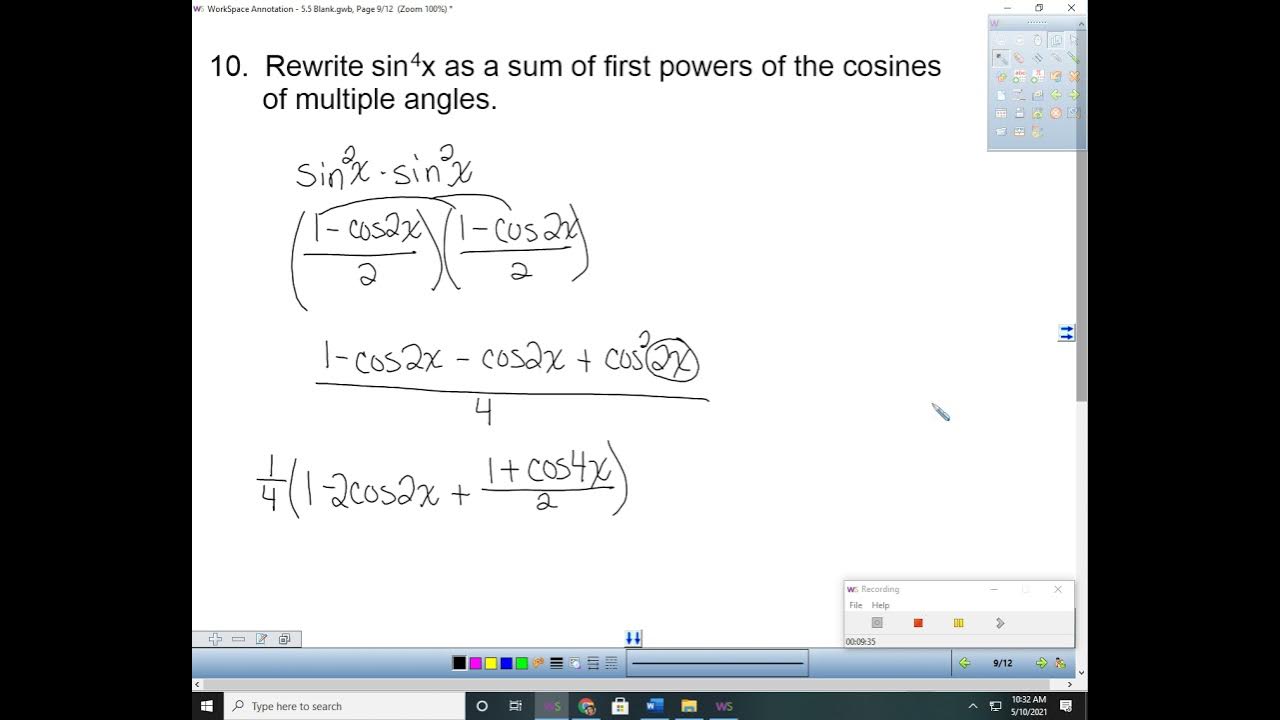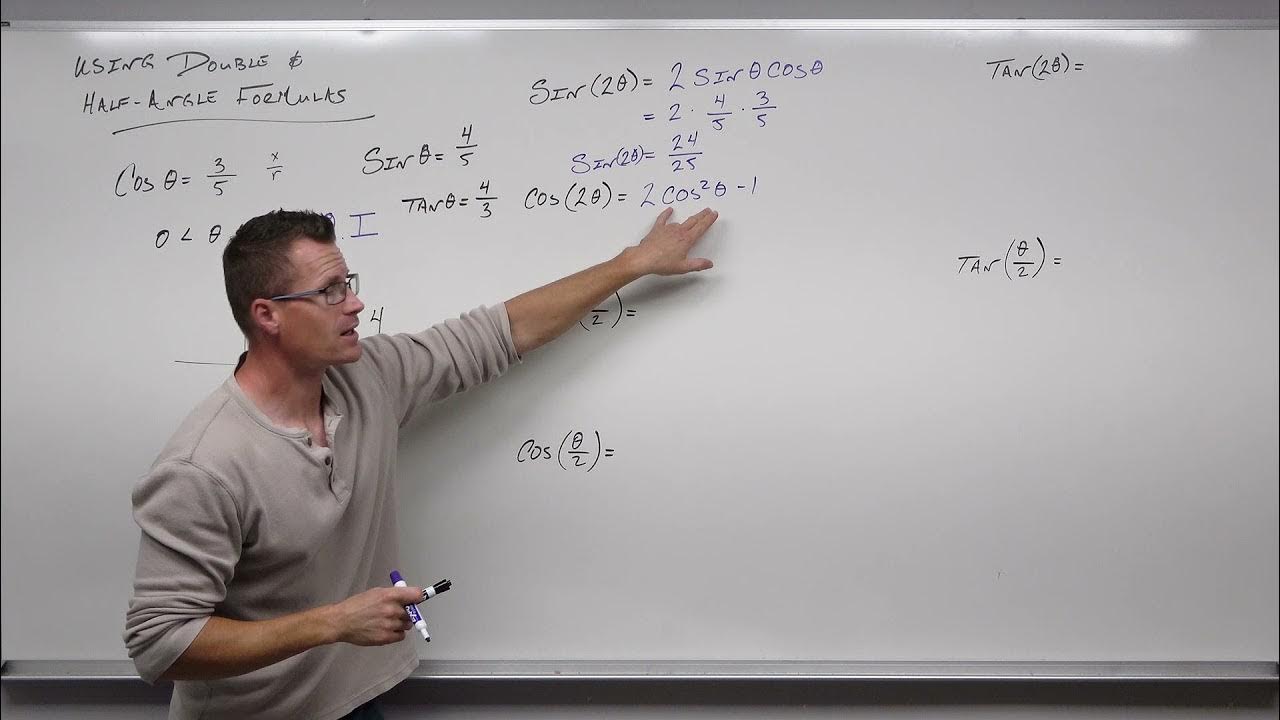Proving the Double and Half Angle Formulas for Trigonometry (Precalculus - Trigonometry 27)
TLDRThis video script offers a comprehensive exploration into the derivation and application of double and half-angle trigonometric formulas, which are crucial for advanced mathematics, particularly Calculus 2. The presenter begins by demonstrating how to prove double-angle formulas for sine and cosine using sum and difference formulas, and then extends the discussion to tangent. The script delves into the manipulation of these formulas to yield additional identities, emphasizing the importance of understanding the Pythagorean identity in the process. The second half of the script focuses on deriving half-angle formulas by substituting angles with half their original measure, which simplifies calculations and makes the formulas more versatile. The presenter also highlights the significance of considering the quadrant of the angle when determining the sign of the sine, cosine, or tangent in half-angle formulas. The script concludes with a promise to show practical applications of these formulas in the subsequent video, encouraging viewers to grasp the foundational concepts before moving on to problem-solving.
Takeaways
- 📚 Start with sum formulas for sine, cosine, and tangent to derive double angle formulas.
- 🔢 Use the identity sin(2θ) = 2sin(θ)cos(θ) to get the double angle formula for sine.
- 📐 For cosine, derive three double angle formulas through manipulations of the Pythagorean identity: cos^2(θ) - sin^2(θ), 2cos^2(θ) - 1, and 1 - 2sin^2(θ).
- 🧮 The double angle formula for tangent is tan(2θ) = 2tan(θ) / (1 - tan^2(θ)) which simplifies to tan^2(θ) = (1 - cos(2θ)) / (1 + cos(2θ)).
- 🤔 Half angle formulas are derived by setting θ = α/2, which simplifies the expressions and makes them easier to work with.
- ➗ The half angle formula for sine is sin(α/2) = ±√[(1 - cos(α))/2], with the sign determined by the quadrant of α/2.
- ➗ The half angle formula for cosine is cos(α/2) = ±√[(1 + cos(α))/2], with the sign determined by the quadrant of α/2.
- ➗ The half angle formula for tangent is tan(α/2) = ±√[(1 - cos(α)) / (1 + cos(α))], again with the sign determined by the quadrant of α/2.
- 🔁 The choice of which double angle formula to use depends on the context and what is more convenient for the problem at hand.
- 📈 The Pythagorean identity (sin^2(θ) + cos^2(θ) = 1) is crucial in deriving and manipulating the double and half angle formulas.
- 📝 Memorize the formulas and understand the quadrant rules for determining the sign of the trigonometric functions to correctly apply the formulas.
Q & A
What is the main topic of the video?
-The main topic of the video is to explain and prove the double and half angle formulas for trigonometric functions, which are particularly useful in calculus 2.
How does the video begin the discussion on double angle formulas?
-The video begins by suggesting that double angle formulas can be derived from the sum and difference formulas for sine and cosine by substituting both angles with the same angle, thus creating a scenario where the angle is effectively doubled.
What is the first double angle formula derived for sine in the video?
-The first double angle formula derived for sine is sin(2θ) = 2sin(θ)cos(θ).
How many double angle formulas are there for cosine?
-There are three double angle formulas for cosine presented in the video.
What mathematical identity is used to manipulate the double angle formulas for cosine?
-The Pythagorean identity, which states that sin²θ + cos²θ = 1, is used to manipulate the double angle formulas for cosine.
What are the three double angle formulas for cosine presented in the video?
-The three double angle formulas for cosine are: cos(2θ) = cos²θ - sin²θ, cos(2θ) = 2cos²θ - 1, and cos(2θ) = 1 - 2sin²θ.
How does the video derive the half angle formulas?
-The video derives the half angle formulas by setting θ to α/2 (half of some other angle α) and then manipulating the previously derived double angle formulas to express them in terms of half the angle.
What is the half angle formula for sine?
-The half angle formula for sine is sin(α/2) = ±√[1 - cos(α)]/2, where the sign (positive or negative) is determined by the quadrant of α/2.
What is the significance of the plus and minus sign in the half angle formulas?
-The plus and minus sign indicates that the value of the trigonometric function at half the angle can be either positive or negative, depending on the quadrant in which the half angle lies.
How does the video use the tangent function to derive a double angle formula?
-The video uses the sum formula for tangent and substitutes both angles with the same angle (2θ) to derive the double angle formula for tangent, which is tan(2θ) = 2tan(θ) / (1 - tan²θ).
What is the final step in deriving the half angle formulas for cosine and tangent?
-The final step in deriving the half angle formulas for cosine and tangent is to take the square root of the expressions derived from the double angle formulas and to account for the sign (positive or negative) based on the quadrant of the half angle.
Outlines
📚 Introduction to Double and Half Angle Formulas
The video begins with an introduction to double and half angle formulas, emphasizing their importance in calculus 2. The speaker explains how these formulas, which may initially seem complex, become more familiar and useful as students progress to higher levels of calculus. The approach involves using known sum and difference formulas for sine, cosine, and tangent to derive new double angle formulas. The process starts with the sum formula for sine and substitutes the same angle (theta) for both angles, leading to the first double angle formula for sine.
🔍 Deriving Double Angle Formulas for Cosine
The video then moves on to derive double angle formulas for cosine. By using the sum formula for cosine and substituting the same angle (theta) for both angles, the presenter simplifies the formula to derive the first double angle formula for cosine. Further manipulation using the Pythagorean identity leads to two additional double angle formulas for cosine, showcasing the versatility of these mathematical relationships.
🧮 Exploring Identities and Double Angle Formulas for Tangent
After discussing sine and cosine, the video delves into tangent. The presenter uses the sum formula for tangent and applies the same substitution technique to derive the double angle formula for tangent. The video also explores the relationship between tangent squared and sine and cosine squared, leading to another identity for tangent squared. This section provides a comprehensive understanding of how to derive and use double angle formulas for tangent.
🔑 Creating Half Angle Formulas from Double Angle Identities
The video then transitions into deriving half angle formulas from the double angle identities. The presenter explains the concept of substituting theta with alpha over 2, which represents half of another angle. This substitution allows the creation of half angle formulas for sine, cosine, and tangent. The speaker emphasizes the importance of considering the quadrant of alpha over 2 to determine the sign (positive or negative) for the half angle formulas.
📐 Applying Quadrant Knowledge to Half Angle Formulas
This section focuses on the application of quadrant knowledge to half angle formulas. The presenter explains how the sign of the sine, cosine, and tangent functions in the half angle formulas is determined by the quadrant of alpha over 2. The video provides a clear explanation of the sign conventions for these functions across different quadrants, which is crucial for accurately applying the half angle formulas.
📝 Summarizing Double and Half Angle Formulas
The video concludes with a recap of all the double and half angle formulas derived in the presentation. The speaker outlines the formulas for sine, cosine, and tangent, and discusses the context in which each formula is most useful. The emphasis is on understanding the derivation process and the underlying mathematical principles, rather than simply memorizing the formulas. The video ends with a teaser for the next video, where the application of these formulas will be explored.
Mindmap
Keywords
💡Double Angle Formulas
💡Half Angle Formulas
💡Sum Formulas
💡Pythagorean Identity
💡Trigonometric Functions
💡Commutative Property
💡Calculus 2
💡Sine of Two Theta
💡Cosine of Two Theta
💡Tangent of Two Theta
💡Sine Squared and Cosine Squared
Highlights
Introduction to proving double and half angle formulas, essential for calculus 2.
Using sum and difference formulas for sine and cosine to develop double angle formulas.
Derivation of the double angle formula for sine: sin(2θ) = 2sin(θ)cos(θ).
Three double angle formulas for cosine derived from the sum formula manipulation.
Application of the Pythagorean identity to express sine squared and cosine squared.
Transformation of the double angle formula for cosine using the Pythagorean identity.
Introduction of two new identities for cosine based on double angle formulas.
Derivation of the double angle formula for tangent: tan(2θ) = 2tan(θ) / (1 - tan²(θ)).
Explanation of how tangent equals sine over cosine and its relation to tangent squared.
Creation of an identity for tangent squared θ using the Pythagorean identity.
Introduction to half angle formulas derived from double angle formulas.
Use of the substitution θ = α/2 to create half angle formulas.
Derivation of the half angle formula for sine: sin(α/2) = ±√[(1 - cos(α))/2].
Explanation of the importance of the quadrant of α/2 in determining the sign of the half angle formula.
Derivation of the half angle formulas for cosine and tangent with considerations for the sign based on the quadrant.
Summary of all the new identities and formulas that can be used for further calculus problems.
Emphasis on the practical application of these formulas in calculus 2 and beyond.
The next video will cover the application of these formulas with examples and equations.
Transcripts
Browse More Related Video

5.5 Multiple Angle and Product to Sum Formulas (Part 2)

How to Use the Double and Half Angle Formulas for Trigonometry (Precalculus - Trigonometry 28)

Half Angle Formulas & Identities - Evaluating Trigonometric Expressions

Trig Identities

Formulas for Trigonometric Functions: Sum/Difference, Double/Half-Angle, Prod-to-Sum/Sum-to-Prod

Verifying Trigonometric Identities With Double Angle Formulas
5.0 / 5 (0 votes)
Thanks for rating: